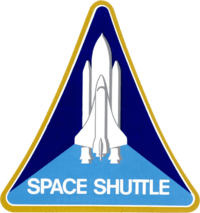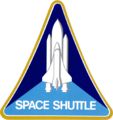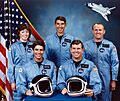STS-61-H facts for kids
| Names | Space Transportation System |
|---|---|
| Mission type | Communications satellites deployment (planned) |
| Operator | NASA |
| Mission duration | 7 days, 7 hours, 51 minutes, 51 seconds (planned) |
| Spacecraft properties | |
| Spacecraft | Space Shuttle Columbia (planned) |
| Launch mass | 1,217,990 kg (2,685,210 lb) |
| Landing mass | 90,584 kg (199,704 lb) |
| Payload mass | 21,937 kg (48,363 lb) |
| Crew | |
| Crew size | 7 (planned) |
| Members | Michael L. Coats John E. Blaha Robert C. Springer Anna L. Fisher James F. Buchli Pratiwi Sudarmono Nigel R. Wood |
| Start of mission | |
| Launch date | 24 June 1986, 13:09:00 UTC (planned) |
| Rocket | Space Shuttle Columbia |
| Launch site | Kennedy Space Center, LC-39B |
| Contractor | Rockwell International |
| End of mission | |
| Landing date | 1 July 1986, 21:00:51 UTC (planned) |
| Landing site | Kennedy Space Center, Runway 15 |
| Orbital parameters | |
| Reference system | Geocentric orbit (planned) |
| Regime | Low Earth orbit |
| Perigee | 285 km (177 mi) |
| Apogee | 295 km (183 mi) |
| Inclination | 28.45° |
| Period | 90.40 minutes |
 Space Shuttle patch  Back row: Anna L. Fisher, Robert C. Springer, James F. Buchli Front row: John E. Blaha and Michael L. Coats |
|
STS-61-H was a NASA Space Shuttle mission that was planned but never flew. It was supposed to launch on June 24, 1986, using the Space Shuttle Columbia. However, the mission was canceled after a very sad event, the Challenger disaster, which happened earlier that year.
Contents
Meet the Astronauts
This mission was planned to have a crew of seven astronauts. They were all ready to go to space and complete their important tasks.
| Position | Astronaut | |
|---|---|---|
| Commander | Would have been second spaceflight |
|
| Pilot | Would have been first spaceflight |
|
| Mission Specialist 1 | Would have been first spaceflight |
|
| Mission Specialist 2 | Would have been second spaceflight |
|
| Mission Specialist 3 | Would have been third spaceflight |
|
| Payload Specialist 1 | Would have been first spaceflight |
|
| Payload Specialist 2 | Would have been first spaceflight |
|
Backup Crew Members
Sometimes, astronauts have backup crew members ready to step in if needed. For STS-61-H, there were two backup payload specialists.
| Position | Astronaut | |
|---|---|---|
| Payload Specialist 1 | Would have been first spaceflight |
|
| Payload Specialist 2 | Would have been first spaceflight |
|
What Was the Mission About?
The main goal of STS-61-H was to launch three important satellites into orbit around Earth. Satellites are like special tools that float in space and help us with many things.
- Palapa B3 and Westar-6S were commercial satellites. This means they would have been used by companies for things like TV broadcasts or phone calls.
- Skynet-4A was a military communication satellite. This type of satellite helps armed forces communicate safely and quickly.
Two of the satellites, the British Skynet and the Indonesian Palapa, were supposed to be launched with an astronaut from their home countries. These astronauts are called "payload specialists" because they are experts on the specific equipment (payload) being carried.
Why the Mission Was Canceled
The Challenger disaster in January 1986 had a huge impact on the Space Shuttle program. After this event, NASA decided to stop using Space Shuttles to launch commercial satellites. This meant that the STS-61-H mission, which was mainly about launching these satellites, had to be canceled.
Because of this change, international astronauts were not chosen for Space Shuttle missions for several years. Sadly, neither the British nor the Indonesian payload specialists from STS-61-H got another chance to fly to space.
However, the main NASA crew members from STS-61-H stayed together. They even practiced for a long simulated mission in 1987. Most of this crew later flew on a different mission called STS-29. On that flight, astronaut James P. Bagian took the place of Anna L. Fisher.
What Happened to the Satellites?
Even though the STS-61-H mission was canceled, the satellites eventually made it to space, but on different rockets and at different times.
- Skynet 4A was launched on January 1, 1990, using a Titan III rocket.
- Westar-6S was renamed Galaxy-6 and launched on October 12, 1992, by an Ariane 44L rocket.
- Palapa-B3 was renamed Palapa B2P and launched on March 20, 1987, with a Delta-3920 rocket.
Images for kids
-
Back row: Anna L. Fisher, Robert C. Springer, James F. Buchli
Front row: John E. Blaha and Michael L. Coats



